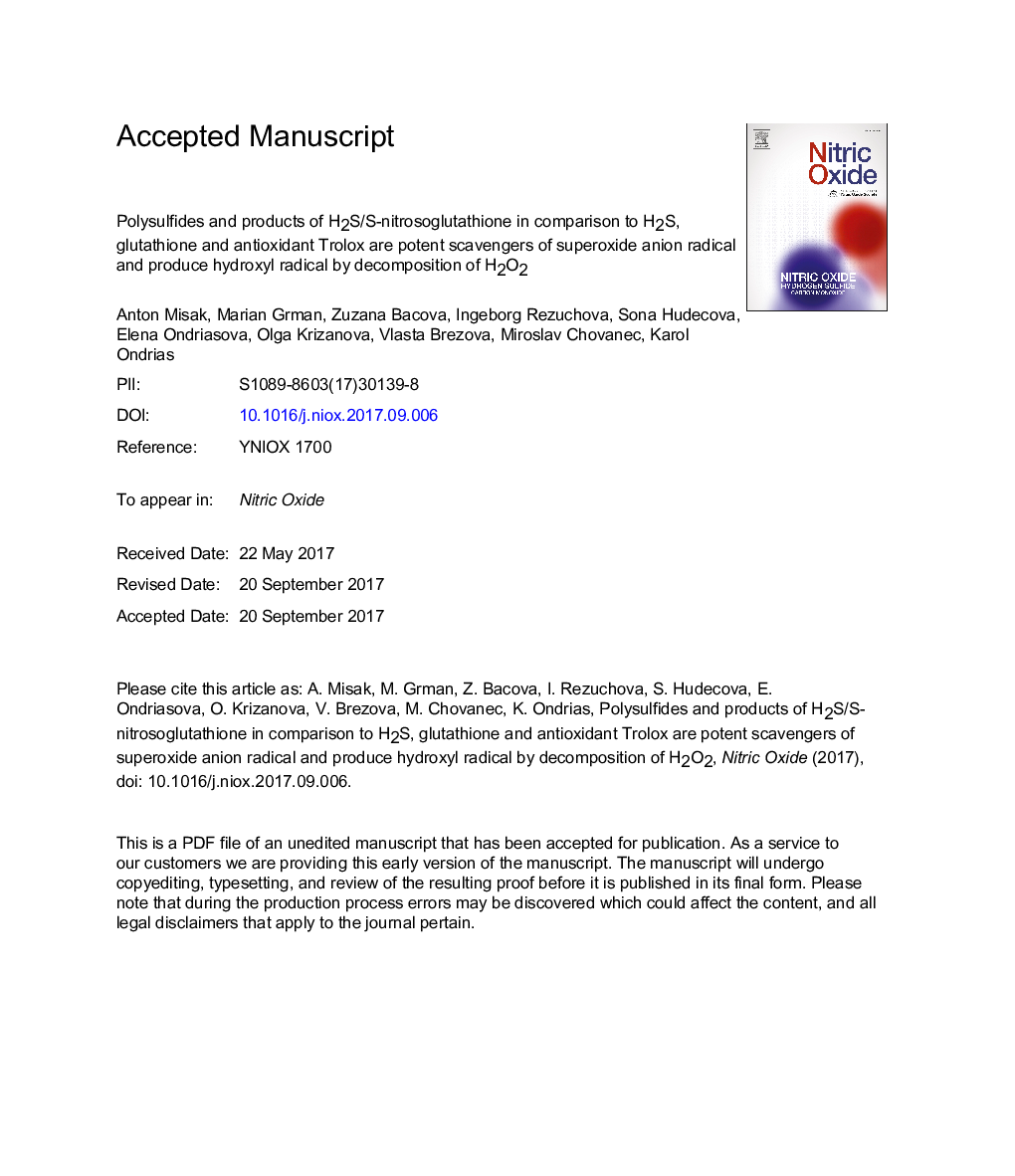| Article ID | Journal | Published Year | Pages | File Type |
|---|---|---|---|---|
| 8344595 | Nitric Oxide | 2018 | 50 Pages |
Abstract
Exogenous and endogenously produced sulfide derivatives, such as H2S/HSâ/S2â, polysulfides and products of the H2S/S-nitrosoglutathione interaction (S/GSNO), affect numerous biological processes in which superoxide anion (O2â) and hydroxyl (OH) radicals play an important role. Their cytoprotective-antioxidant and contrasting pro-oxidant-toxic effects have been reported. Therefore, the aim of our work was to contribute to resolving this apparent inconsistency by studying sulfide derivatives/free radical interactions and their consequent biological effects compared to the antioxidants glutathione (GSH) and Trolox. Using the electron paramagnetic resonance (EPR) spin trapping technique and O2â, we found that a polysulfide (Na2S4) and S/GSNO were potent scavengers of O2â and cPTIO radicals compared to H2S (Na2S), GSH and Trolox, and S/GSNO scavenged the DEPMPO-OH radical. As detected by the EPR spectra of DEPMPO-OH, the formation of OH in physiological solution by S/GSNO was suggested. All the studied sulfide derivatives, but not Trolox or GSH, had a bell-shaped potency to decompose H2O2 and produced OH in the following order: S/GSNO > Na2S4 â¥Â Na2S > GSH = Trolox = 0, but they scavenged OH at higher concentrations. In studies of the biological consequences of these sulfide derivatives/H2O2 properties, we found the following: (i) S/GSNO alone and all sulfide derivatives in the presence of H2O2 cleaved plasmid DNA; (ii) S/GSNO interfered with viral replication and consequently decreased the infectivity of viruses; (iii) the sulfide derivatives induced apoptosis in A2780 cells but inhibited apoptosis induced by H2O2; and (iv) Na2S4 modulated intracellular calcium in A87MG cells, which depended on the order of Na2S4/H2O2 application. We suggest that the apparent inconsistency of the cytoprotective-antioxidant and contrasting pro-oxidant-toxic biological effects of sulfide derivatives results from their time- and concentration-dependent radical production/scavenging properties and their interactions with O2â, OH and H2O2. The results imply a direct involvement of sulfide derivatives in O2â and H2O2/OH free radical pathways modulating antioxidant/toxic biological processes.
Keywords
5-(diethoxyphosphoryl)-5-methyl-1-pyrroline N-oxidenitrosopersulfideDEPMPOS-nitrosoglutathioneGSNOGSH(±)-6-hydroxy-2,5,7,8-tetramethylchromane-2-carboxylic acid2-(4-carboxyphenyl)-4,4,5,5-tetramethylimidazoline-1-oxyl-3-oxidecPTIOROSAntioxidantDNA cleavageTroloxElectron paramagnetic resonanceEPRHydroxyl radicalSulfideSuperoxideEPR spectroscopyNitric oxideGlutathioneReactive oxygen species
Related Topics
Life Sciences
Biochemistry, Genetics and Molecular Biology
Biochemistry
Authors
Anton Misak, Marian Grman, Zuzana Bacova, Ingeborg Rezuchova, Sona Hudecova, Elena Ondriasova, Olga Krizanova, Vlasta Brezova, Miroslav Chovanec, Karol Ondrias,
